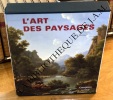7 books for « buttner nils »Edit
-
Type
Book (6)
New book (1)
-
Language
French (6)
Italian (1)
-
Topics
Belgium (1)
History (1)
Industrial arts & crafts - fine arts (1)
Rubens (2)
-
Countries
Belgium (2)
France (2)
Switzerland (2)
United Kingdom (1)
[Sir Peter Paul Rubens] - Buttner, Nils, Anna Orlando
Reference : 122428
(2022)
ISBN : 9788892822795
Rubens a Genova
Buttner, Nils, Anna Orlando: Rubens a Genova. Exhibition: Genoa, Palazzo Ducale, 2022. 413 pages. Fully illustrated in colour. Paperback. 28x24cms. A consideration of Rubens' production in Genoa. Six chapters discuss his relationship with the city, its architecture, court life and political and social context. Also considers Rubens' depiction of women, important clients like Ambrogio Spinola and his treatment of the sacred and the profane. Each chapter includes a catalogue of exhibition highlights including illustrations, comparanda, provenance and bibliographies. Concludes with an exhibition checklist and layout. Text in Italian.
A consideration of Rubens' production in Genoa. Six chapters discuss his relationship with the city, its architecture, court life and political and social context. Also considers Rubens' depiction of women, important clients like Ambrogio Spinola and his treatment of the sacred and the profane. Each chapter includes a catalogue of exhibition highlights including illustrations, comparanda, provenance and bibliographies. Concludes with an exhibition checklist and layout. Text in Italian
Prinzessinnen und Heilige/Princesses and Saints
Arnoldsche Verlagsanstalt (9/2016)
LIVRE A L’ETAT DE NEUF. EXPEDIE SOUS 3 JOURS OUVRES. NUMERO DE SUIVI COMMUNIQUE AVANT ENVOI, EMBALLAGE RENFORCE. EAN:9783897904804
L'ART DES PAYSAGES
Éditeur : Citadelles & Mazenod Parution : 2007 Format : 28,5 x 33cm 416 pages Comme neuf Très nombreuses illustrations couleur Relié en toile sous jaquette et coffret illustrés
Rubens prive De meester portretteert zijn familie
, Editions Marot , 2015 Hardback, 290x245mm, 272p, 200 colour illustrations, Dutch (NL) edition. ISBN 9782930117478.
In het voorjaar van 2015 loopt een unieke tentoonstelling over Peter Paul Rubens als portretschilder. Rubens had naar eigen zeggen een hekel aan het schilderen van portretten. En het stond in zijn tijd niet hoog aangeschreven in de kunsttheorie. Maar toch is Rubens een van de knapste portrettisten van zijn tijd. Zijn allermooiste en meest intieme portretten zijn ongetwijfeld de beeltenissen van zijn familie: zijn beide echtgenotes - de jong gestorven Isabella en beeldschone Helena -, zijn kinderen, zijn schoonzussen en zijn zwagers. En natuurlijk portretteerde de meester ook zichzelf. Deze werken werden niet in opdracht maar uit liefde geschilderd en dienden voor de memorie. Voor het eerst worden deze verbluffende kunstwerken gezamenlijk getoond en wel op de plaats waar zij thuishoren: de voormalige woning van Rubens in Antwerpen. De tentoonstelling is samengesteld door internationale Rubensspecialisten en laat een vijftigtal schilderijen en tekeningen zien, uit topmusea, waaronder de Uffizi in Florence, het British Museum in Londen, het Musee du Louvre in Parijs, de Hermitage in Sint-Petersburg, en de collecties van de Prins van Liechtenstein en de Engelse koningin.
Jardins en peinture
Imprimerie nationale (3 septembre 2008)
Relié, jaquette illustrée, nombreuses illustrations, comme neuf. Coins légèrement frappés.
Allegories and Subjects from Literature. 2 volumes.
, Brepols - Harvey Miller, 2018 Hardback,Languages: English , 2 vol., 856 p., 211 b/w ill. + 97 colour ill., 180 x 265 mm. ISBN 9781912554119.
Rubens had a profound impact on the visual culture of his age. He was admired not only as a painter but also for his learning, for the knowledge of classical literature and imagery which he exploited so brilliantly in arresting and powerful pictures. Rubens was particularly drawn to allegory, to the use of personified figures, sometimes in combination with the gods of the ancient pantheon and certain humans (historical individuals), to express concepts, ideals and even political messages. A contemporary praised him for using in his allegorical compositions ?only symbols of Antiquity, thus popularising the coins and other monuments of the ancient world', but Rubens adapted ancient symbolism to new effect, with the aim of creating pictures whose essential meaning would be the more accessible for it. This volume presents works that Ludwig Burchard (1886?1960) planned to include in his catalogue raisonne under the heading ?Allegories and Subjects from Literature?. It features some of the artist?s most celebrated paintings, as well as some lesser-known or recently discovered items. The themes range from nature?s abundance to the dangers of excess, from human love to political expediency, triumph and the celebration of religion. It includes masterpieces as diverse in tone as the Shivering Venus (Antwerp, Koninklijk Museum voor Schone Kunsten) and the Horrors of War (Florence, Palazzo Pitti), memorably described by a great historian as ?the immortal and unforgettable frontispiece to the Thirty Years? War?. As well as an introduction to the subject, the catalogue provides extensive analyses of each work, revealing Rubens? literary and visual references. The circumstances surrounding the making and display of every item are investigated and considered alongside the artist?s own creative process, since knowledge of the intended context and the early viewing conditions of Rubens? works is so important to the understanding of their significance. Thus particular attention is paid to provenance, not only for the works themselves, but for the copies made after them.
L'ART DES PAYSAGES.
In-folio, reliure éditeur et emboitage éditeur, 415 pages, état proche du neuf.
En l'état hors...................... frais d'envoi............
 Write to the booksellers
Write to the booksellers





